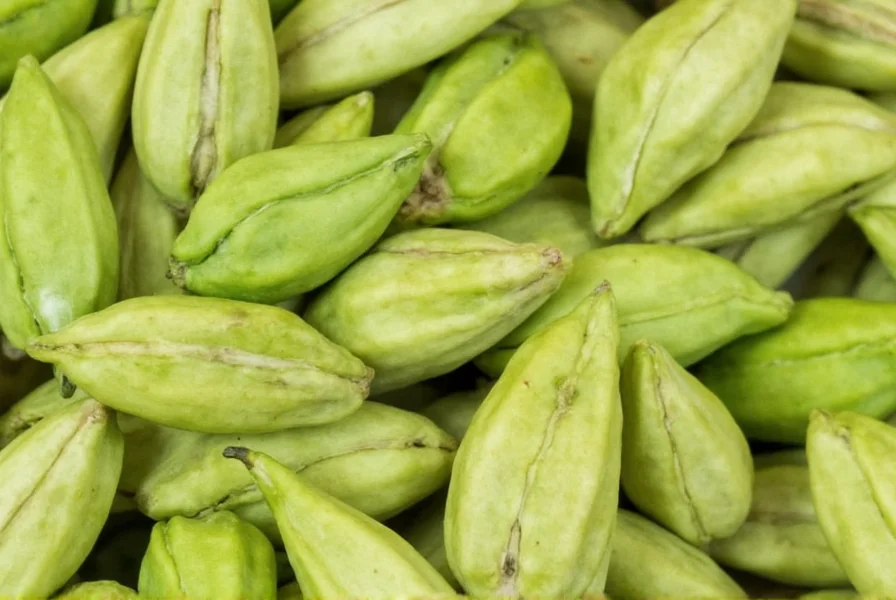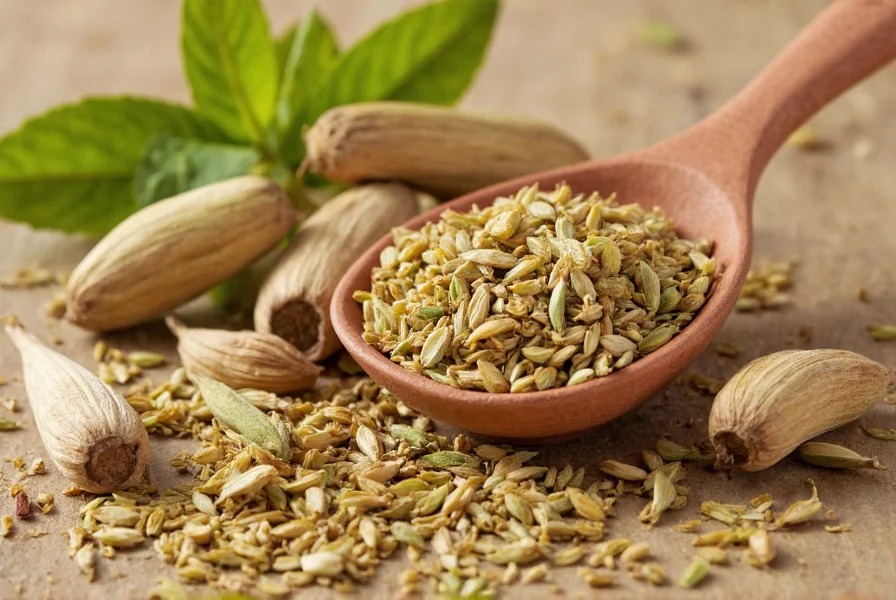Understanding the distinctive scent of cardamom requires exploring both its chemical composition and sensory characteristics. This ancient spice, harvested from the Elettaria cardamomum plant's seed pods, has been prized for millennia not just for its flavor but for its remarkable aromatic properties that distinguish it from other spices.
The Science Behind Cardamom's Signature Scent
Cardamom's complex aroma results from over 100 volatile compounds working in harmony. The most significant contributors include:
| Compound | Percentage in Essential Oil | Sensory Contribution |
|---|---|---|
| α-Terpinyl acetate | 30-50% | Citrusy, floral notes (primary characteristic) |
| 1,8-Cineole (eucalyptol) | 20-30% | Cool, medicinal, eucalyptus-like freshness |
| Limonene | 5-15% | Citrus undertones |
| Terpinene | 3-10% | Herbal, pine-like notes |
These compounds interact to create cardamom's signature scent profile that food scientists describe as having "high odor activity value"—meaning even small amounts significantly impact the overall aroma of dishes and environments.

Green vs Black Cardamom: Distinct Aromatic Profiles
Not all cardamom smells the same. The two primary varieties offer notably different aromatic experiences:
- Green cardamom (true cardamom): Features a brighter, more citrus-forward aroma with pronounced floral notes. Often described as "the queen of spices" for its delicate yet complex scent profile. Best experienced when pods are freshly crushed.
- Black cardamom: Offers a smokier, more camphorous scent due to the traditional drying process over open flames. Contains higher concentrations of cineole, giving it a distinctive medicinal quality that works well in savory applications but differs significantly from green cardamom's profile.
Understanding these differences helps explain why recipes specifying "cardamom" without clarification can yield varying results—the aromatic impact differs substantially between varieties.
How Cardamom's Scent Compares to Other Spices
Cardamom's unique aroma profile doesn't have a perfect counterpart among spices, but understanding its relationship to other common spices provides helpful context:
- Unlike cinnamon's straightforward sweetness or cloves' singular pungency, cardamom offers multiple aromatic dimensions that evolve as you smell it
- Shares some citrus notes with coriander but with greater complexity and floral elements
- Contains similar eucalyptus notes to bay leaves but in a brighter, less medicinal concentration
- When comparing cardamom smell to ginger, the former is more floral and citrusy while ginger offers sharper, more pungent heat
Professional chefs and perfumers often describe cardamom's scent as occupying a unique space between citrus, floral, and herbal categories—making it difficult to substitute without altering a dish's aromatic profile significantly.
Factors Influencing Cardamom's Aromatic Quality
Several elements affect how strongly and authentically cardamom expresses its characteristic scent:
- Form: Whole pods retain aroma significantly longer than pre-ground spice—up to 12 months versus 3-6 months
- Freshness indicators: High-quality cardamom should release immediate citrus-floral notes when pods are squeezed; stale cardamom smells dusty or one-dimensional
- Storage conditions: Exposure to light, heat, and air rapidly degrades the volatile compounds responsible for cardamom's distinctive smell
- Geographic origin: Cardamom from Guatemala (the world's largest producer) tends toward brighter citrus notes, while Indian varieties often feature more pronounced herbal undertones

Cultural Perspectives on Cardamom's Aroma
Cultures worldwide have developed distinctive relationships with cardamom's scent:
- In Scandinavian countries, cardamom's sweet-spicy aroma defines traditional baked goods like kardemummabullar
- Middle Eastern coffee culture relies on cardamom's citrusy warmth to balance coffee's bitterness in preparations like qahwa
- Indian cuisine uses cardamom's complex scent profile as both a flavor enhancer and digestive aid in spice blends like garam masala
- Aromatherapists value cardamom oil's stimulating yet calming properties, noting its ability to simultaneously refresh and comfort
These diverse applications demonstrate how cardamom's unique scent profile serves multiple sensory and functional purposes across different culinary traditions.
Practical Applications of Cardamom's Aromatic Properties
Understanding cardamom smell characteristics helps optimize its use in various applications:
- Culinary uses: Crush pods just before use to maximize aromatic impact; the volatile compounds begin dissipating immediately upon exposure to air
- Beverage enhancement: Cardamom's citrus notes complement coffee and tea without requiring added sweeteners—try lightly crushing a pod directly in your cup
- Aromatic preservation: Store whole pods in airtight containers away from light; consider freezing excess pods to maintain peak aroma for up to 18 months
- Sensory pairing: Cardamom's complex scent profile harmonizes particularly well with citrus fruits, vanilla, chocolate, and other warm spices like cinnamon and cloves
When exploring what does cardamom smell like in different contexts, note that heat application transforms its aroma—initially releasing bright citrus notes, then developing warmer, more complex undertones as cooking progresses.
How to Fully Experience Cardamom's Aromatic Complexity
To properly appreciate cardamom's distinctive scent profile:
- Select plump, green pods that feel heavy for their size (indicating high essential oil content)
- Gently crush a single pod between your fingers to release the volatile compounds
- Breathe deeply but gently—cardamom's aroma can be surprisingly intense
- Note the progression: initial citrus burst, followed by floral notes, then the subtle eucalyptus undertone
- Compare to pre-ground cardamom to appreciate the dramatic difference in aromatic complexity
This mindful approach reveals why cardamom has maintained its status as one of the world's most prized spices for over 4,000 years—the depth and evolution of its scent profile remain unmatched by artificial substitutes.
Frequently Asked Questions
Why does cardamom smell like eucalyptus?
Cardamom contains 1,8-cineole (eucalyptol), the same primary compound found in eucalyptus oil. This chemical gives both substances their distinctive medicinal, cooling quality. In cardamom, cineole typically comprises 20-30% of the essential oil content, creating that characteristic fresh, slightly medicinal undertone beneath the citrus and floral notes.
Does cardamom smell different when cooked?
Yes, cardamom's aroma transforms significantly with heat. Initially, heating releases the more volatile citrus compounds (limonene and α-terpinyl acetate), creating a bright, lemony scent. As cooking continues, the less volatile compounds like cineole become more prominent, yielding the characteristic warm, slightly medicinal aroma associated with dishes like Indian curries or Scandinavian pastries. This evolution makes cardamom particularly valuable for complex flavor development.
How can you tell if cardamom has lost its aroma?
Fresh cardamom should release an immediate, complex aroma when pods are squeezed. Stale cardamom shows these signs: minimal scent when crushed, a one-dimensional or dusty smell, brownish seeds instead of green-gray, and lightweight pods (indicating dried-out essential oils). Properly stored whole pods maintain their distinctive cardamom smell characteristics for 12-18 months, while ground cardamom loses potency within 3-6 months.
Why does my cardamom smell musty?
A musty cardamom smell typically indicates improper storage or age. Cardamom absorbs moisture easily, which degrades the volatile compounds responsible for its characteristic scent. Exposure to humidity, light, or air causes the essential oils to oxidize, resulting in that unpleasant mustiness. To prevent this, store cardamom in an airtight container in a cool, dark place, and avoid keeping it near strong-smelling foods that could transfer odors.
Is cardamom's scent stronger in certain varieties?
Yes, green cardamom generally has a more pronounced and complex aroma than black cardamom. Within green cardamom varieties, Malabar cardamom from India tends to have more herbal notes while Mysore cardamom offers brighter citrus characteristics. The highest quality cardamom (often labeled 'Allepey extra bold') contains the highest concentration of essential oils, yielding the most intense and well-balanced scent profile with optimal citrus, floral, and eucalyptus notes.











 浙公网安备
33010002000092号
浙公网安备
33010002000092号 浙B2-20120091-4
浙B2-20120091-4